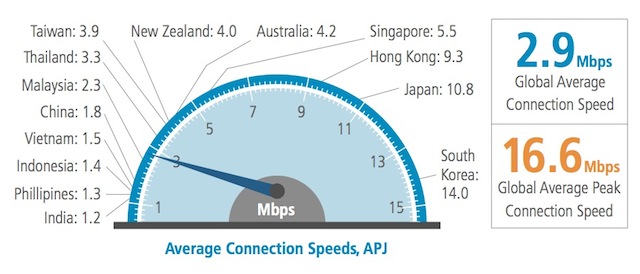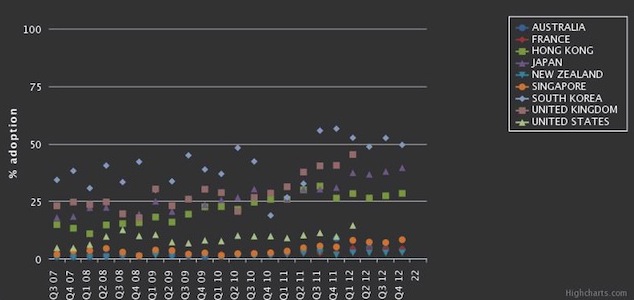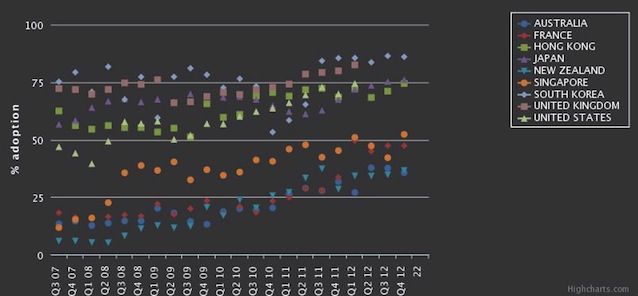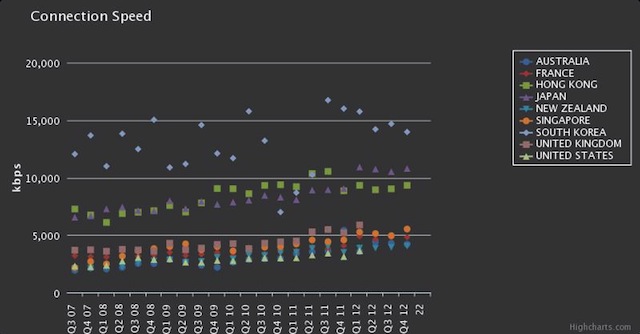
news Australia’s average Internet speeds have decreased by 23% compared with a year ago, according to the latest quarterly figures from global content distribution network (CDN) giant Akamai.
The company’s Q4 2012 State of the Internet report (available for download here, or read the executive summary here), compiled from a significant volume of usage data based on the company’s delivery of streaming and static content around the world, put Australia well behind advanced Asian countries, the United States and UK in key metrics.
Charts of the number of connections to Akamai that were faster than 10Mbps, for example – classified as ‘high broadband adoption’ – placed Australia (at 3.84%) ahead of New Zealand (2.42%) but well behind the US (19.5%), UK (11.47%), Hong Kong (approx. 27%), Japan (39.48%), South Korea (49.41%) and Singapore (approx. 8%).
Embarrassingly, Australia also lags most developed countries in Akamai’s measures of connections faster than 4Mbps – ‘broadband adoption’, in Akamai parlance, with the UK (64.44%), US (65.76%), South Korea (86.00%), New Zealand (36.55%), Russia (51.90%), Portugal (56.20%), Japan (76.07%), France (47.34%), Canada (71.78%), Finland (62.16%) and even New Zealand (36.55%) all besting Australia’s broadband adoption rate of 35.57%.
This lack of momentum is reflected in average Australian connection speeds, which were flagged as being 2.3% less than in Q3 2012, while average Australian speeds dropped 23% year-on-year overall.
Interestingly, average peak connections in Australia were 23.4Mbps in 2012 – down 28% compared with 2011 – which hit Australia’s fast broadband ranking. Australia and South Korea were the only Asia-Pacific countries to see high broadband adoption rates decline year over year – by 56% and 13% respectively – compared with the same period in 2011.
The results must be taken with a grain of salt, since they only reflect usage on Akamai’s network: therefore, the loss of a major Australian video-streaming client, for example, might skew results towards lower-speed broadband. Akamai says that it recorded nearly 700 million unique IP addresses from 240 regions during the quarter – representing a 10% increase over 4Q2011.
The overall figures may also not reflect the popularity of mobile broadband in Australia, where average connection speeds are slower than on fixed land-line services but usage is relatively high. With average peak connection speeds of 17.13Mbps and average connection speeds of 2.45Mbps, Akamai figures ranked Australia’s mobile connectivity third in the Asia-Pacific region, behind mobile carriers in Hong Kong and Malaysia and just ahead of New Zealand, Hong Kong, Indonesia, Sri Lanka, Taiwan, and others.
The Akamai report also looked at the various countries as sources of security attacks. In this metric, China (41%) far outstripped the rest of the top ten, which included the US (10%), Turkey (4.7%), Russia (4.3%), Taiwan (3.7) and others.
Image credits: Akamai




Perhaps the drop is due to Failstra letting the copper get even worse as they thought the NBN was going to replace it. Now Fraudband is going to rely on it. Lib – Fail party!
This is exactly what happened to me, I use to get 12mbit on my adsl2 connection and it all of a sudden dropped to 8mbit. Telstra tried to fix it by replacing the line between the footpath and my house and also gave me a new modem but neither fixed the speed. Telstra said in the end that the 8mbit meets their minimum requirements so they weren’t going to do anything more to fix it. This is another good example of why the copper needs to be replaced.
Consider yourself lucky with 8Mbps. When my copper went so wonky I could barely hear the person on the other end of a voice call and I was getting 384kbps download speeds tops, the Telstra tech came out for a while, fiddled with the line, got rid of the static and pronounced my line clear.
Two days later the static was back and Telstra came back, but never managed to fix it. My support call apparently got lost somewhere in a too-hard basket in their customer service department somewhere.
I now have no Telstra home services at all, so I guess that was that.
That ‘average’ speed would be a lot lower still if it included those of us that don’t bother visiting a streaming site due to inadequate download speed.
> That ‘average’ speed would be a lot lower still if it included those of us that don’t bother visiting a streaming site due to inadequate download speed.
Akamai provide a content distribution service. It is highly likely that you have connected to their servers considering their customers include Apple, Microsoft, Amazon, Adobe, Yahoo, Facebook, Twitter, etc.
The copper seems to be drying up.
Basically, no new copper infrastructure is going into existing areas (basically because government has made a commitment that NBN will overbuild all copper). However, new buildings are going up, and new buildings require services. Thus, the existing infrastructure is being shared amongst more and more people.
It happened to me. I terminated my naked-DSL service with iiNet, and tried to move to a different provider. What I got told was “wait two weeks”, then I got told “wait another two weeks”, and then got some story about floods and cyclones, and finally I got told there’s no copper lines available. Strangely though, I can check under the house and exactly the same copper line is still there since I’ve been using it with iiNet for years. Anyhow, there you go, no copper available.
NBN of course, won’t be in my area for many years to come (at best) or probably never (being realistic) which leaves me with wireless.
I foresee a slow landslide toward wireless that will outrun NBN’s even slower rollout. Interesting to see what happens, this could yet be good for Australia. I’m currently spending less money on wireless, but also using it less, and discovering new levels of personal productivity away from the Internet. Funny how the world works, expect the unexpected.
Anecdotal evidence much?
No, I could see it happening. if a user got naked, disconnected, Telstra loses track of the line, they work out they could make do on wireless because while they were of line they got so heavily involved in the young liberals. I could see dozens of people having this experience. The lack of those people could tip the NBN from profit to make a lose. ;)
Until there friends go…”dude you are on wireless. Wow this sucks, why aren’t you on fibre man.. it rocks hard”
I am of course paraphrasing… No one uses “dude” anymore ;-)
I can believe it… Our ADSL2+ dropped into the low kb/s range after the big storms earlier in the year in Brisbane, and even though Telstra have fixed it (took a good month and a half for them to come – for comparison, Energex had the power fixed in a day) we only get three or four Mbit vs the 6 Mbit we used to get…
I really hope that NBNCo have the three-year rollout contracts locked in, because I will seriously move to the southside area for fibre in two years if they build it…
Figures that are missing, which would provide clarity on the declining average speeds, are the take up numbers.
The number of connections, fibre, DSL, HFC, mobile, etc.
Have the number of connections gone up considerably from 2011 to 2012?
I would hazard a guess, and say mobile connections have increased substantially, based on the sales figures of products from Apple and Samsung, as well as the slew of new mobile broadband products allowing mobile wifi.
Mobile broadband as it is in Australia, would suffer under increased load, and thus push the average speeds down. The launch of 4G has helped understandably, taking load off 3G, but as a consumer, I wouldn’t know how Telstra balance the spectrum between these two broadcast technologies, and maintain the highest bandwidth available to customers.
Current sync download speed 3456 kbps.
I should point out, I want to watch GoT, not own GoT.
This is one of the biggest reasons I haven’t signed up for the iTunes release.
I’ve gone through the collection phase, and realised I don’t re-watch 90% of the stuff I’ve bought. I’ve got enough DVDs on my shelves now, that I don’t need. I buy em at $24-30 each, and can only get $1 back on them at Cash Converters years later. Damn waste of money I can spend on things I really need.
I need to rent GoT, but there is no rental option for just aired episodes, especially in HD.
Whoops, comment thread.
Did anyone stop to think that this reduction is due to more people using 3G for their browsing and disconnecting adsl?
Adsl is generally slower than adsl and with a greater % moving to cut the wire, is it any wonder.
Comments are closed.